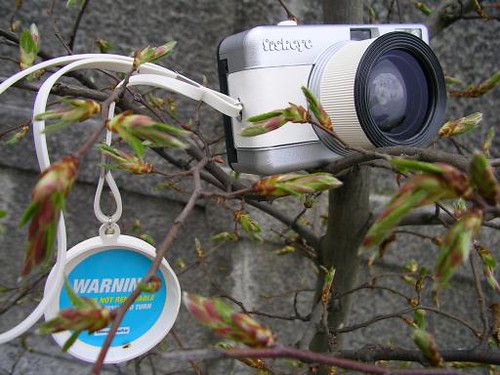Lomography
Lomography, a registered trademark of Lomographische AG (Austria). The Lomography Society International promotes the use of playful and "lo-fi" cameras—originally beginning with the Lomo copy of the Cosina CX-2, the LC-A. Since then, many whimsical and intentionally-flawed cameras have been promoted, along with a "shoot from the hip" aesthetic. Viewed as either a modern impressionistic art movement, or a simple (and effective) marketing ploy, Lomography has attracted a large international following around "The 10 rules"
Contents
10 Golden Rules
- Take your camera everywhere you go.
- Use it anytime - day or night.
- Lomography is not an interference in your life, but a part of it.
- Shoot from the hip.
- Approach the objects of your lomographic desire as close as possible.
- Don't think. (William Firebrace)
- Be fast.
- You don't have to know beforehand what you've captured on film.
- You don't have to know afterwards, either.
- Don't worry about any rules.
The photographic results of "Lomography"
Subjects
Everyday people, colorful objects, and unusual or surreal situations and people are just a few examples of common lomographic subjects.
Focus
Many lomography cameras have unpredictable focal lengths, and due to the plastic lens on almost all lomography cameras, sharp focus is uncommon. Every lens is a little bit different, but that is part of the nature of lomography!
Degraded edges
Many lomography cameras feature degrading around the edges of the images, also called vignetting. The cameras which provide this effect are usually Holga or the Diana. Vignetting is most pronounced with the use of medium format film on a 12 shot setting without the use of a frame mask.
Unexpected Colors and Effects
Probably the most profound aspect of lomography is the unexpected and widely varying saturation, random lens flashes, light leaks, and double exposures. Although achieving these effects is undesirable in traditional photography, they are the entire goal of lomography.
Viral marketing
As this movement was created and is run by the "Lomographic Society", the sole legal importer of LOMO products to the United States, many have suggested that the Lomographic movement was started as a viral marketing campaign. The Lomographic Society was able to increase the demand for its products by creating a group of which its customers would instantly become members. This increased demand led to increased prices - the LOMO LC-A, for example, would cost about $30 US in the former Soviet Union. If bought through the Lomographic Society, the same camera would cost $200 US. Judged in terms of profit and generated hype, this marketing campaign has been very effective.
Cameras sold by Lomography

|
| Lomography Diana shop window display by AWCam |
In addition to the cameras made by the LOMO factory, Lomographic also sells other cameras:
- Diana Plus
- Lomographic ActionSampler (and Flash model)
- Lomographic Colorsplash Camera
- Lomographic Fisheye Camera
- Lomographic Frogeye Underwater
- Lomographic Oktomat
- Lomographic Pop9
- Lomographic SuperSampler
- Lomolitos Single Use
- Polaroid Spectra Blitz
Links
- Lomographic Society International
- Flickr Lomography Group
- Lomography News
- Why I don't like Lomography, from Alfred Klomp's camera site
- Emulating the Lomo effect in Gimp
- Emulating the Lomo effect in Photoshop
